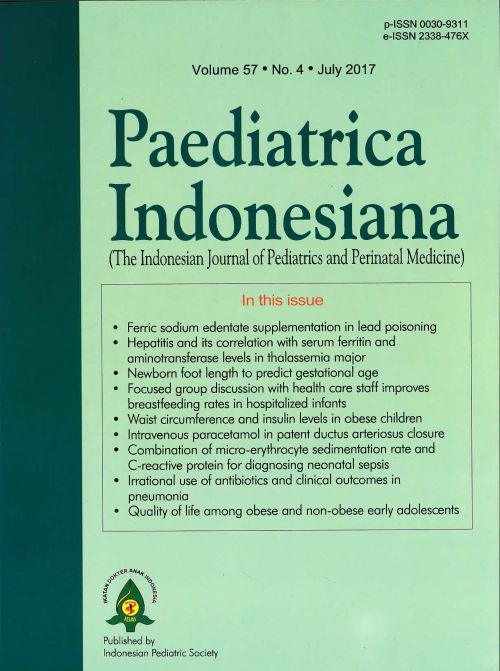Waist circumference and insulin levels in obese children
DOI:
https://doi.org/10.14238/pi57.4.2017.194-7Keywords:
waist circumference, insulin level, obese, childrenAbstract
Background Childhood obesity is one of the most serious public health challenges of the 21st century. Its prevalence has increased at an alarming rate. Overweight and obese children are prone to obesity in adulthood and to developing non-communicable diseases (NCDs) like diabetes and cardiovascular diseases at a younger age. Increased waist circumference has been shown to contribute to the risk of metabolic syndrome in obese adults.
Objective To assess for a correlation between waist circumference and insulin level in obese children.
Methods In this cross-sectional study, obese children aged 6-10 years were included by consecutive sampling. We excluded children with infectious disease, malignancy, dyslipidemia, type 2 diabetes mellitus, or those who had not fasted before the blood draw. Subjects underwent waist circumference and fasting blood glucose measurements. Serum insulin levels were examined by enzyme-labeled chemiluminescent immunometric assay,after subjects had fasted for 10-14 hours. Data were analyzed by correlation analysis.
Results Subjects had a mean waist circumference of 80.2 cm (SD 7.2) and mean insulin level of 10.70 (SD 7.5). µIU/mL Pearson’s correlation test revealed a significant, moderately positive correlation between waist circumference and elevated insulin level (r=0.45; P=0.006).
Conclusion Waist circumference and insulin level have a significant, moderate, positive correlation in obese children. As such, waist circumference may be a simple method for early detection of hyperinsulinemia, as a risk factor for metabolic syndrome.
References
Dehghan M, Akhtar-Danesh N, Merchant AT. Childhood obesity, prevalence and prevention. Nutr J. 2005;4:24.
Badan Penelitian Dan Pengembangan Kesehatan Kementerian Kesehatan RI. Riset Kesehatan Dasar (RISKERDAS). 2013. [cited 2016 May 5]. Available from: http://www.depkes.go.id/resources/download/general/Hasil%20Riskesdas%202013.pdf
Yoga P, Sidiartha, IGL. Prevalence and characteristics of childhood obesity in Pediatrics Outpatient Clinic, Sanglah Hospital Denpasar. Jurnal Ilmu Kesehatan Anak. 2013;1:55-64.
Abdelghaffar S, Hafez MH, Shaaban FA, Abou Esmail LA, Salama SI, Rashed RG. Resistin and Obesity-Associated Insulin Resistance in Children. J Am Sci. 2010;6:256-66.
Lone SW, Atta I, Ibrahim MN, Leghari TM, Khan YN, Raza J. Hyperinsulinemia and waist circumference in childhood metabolic syndrome. J Coll Physicians Surg Pak. 2011;21:146-50.
Bedogni G, Iughetti L, Ferrari M, Malavolti M, De Simone M, Fiori G, et al. Association of waist circumference and body mass index with fasting blood insulin in severely obese children: a cross sectional study. Diabetes Nutr Metab. 2002;15:160-4.
Romualdo MC, Nobrega FJ, Escrivao MA. Insulin resistance in obese children and adolescents. J Pediatr (Rio J). 2014;90(6):600-7.
Rizk NM, Yousef M. Association of lipid profile and waist circumference as cardiovascular risk factors for overweight and obesity among school children in Qatar. Diabetes Metab Syndr Obes. 2012;5:425-32.
Van der Aa MP, Fazeli Farsani S, Knibbe CA, de Boer A, van der Vorst MM. Population-based studies on the epidemiology of insulin resistance in children. J Diabetes Res. 2015;2015:1-9.
Romero-Velarde E, Vásquez-Garibay EM, Ãlvarez-Román YA, Fonseca-Reyes S, Toral EC, Sanromán RT. Waist circumference and association with cardiovascular risk factors in obese children and adolescents. Bol Med Hosp Infant Mex. 2013;70:358-63.
Ariani A, Sembiring T. Prevalensi obesitas pada anak sekolah dasar di kota Medan. Majalah Kedokteran Nusantara. 2007;40:86-9.
Dewi MR, Sidiartha IGL. Prevalence and risk factors of obesity in primary school in urban and rural areas. Medicina. 2013;44:15-21.
Masquio DCL, Ganen AP, Campos RMS, Sanches PL, Corgosinho FC, Caranti D, et al. Cut-off values of waist circumference to predict metabolic syndrome in obese adolescents. Nutr Hosp. 2015;31:1540-50.
Schuster J, Vogel P, Eckhardt C, Morelo SD. Applicability of the visceral adiposity index (VAI) in predicting components of metabolic syndrome in young adults. Nutr Hosp. 2014;30:806-12.
Piya MK, McTernan PG, Kumar S. Adipokine inflammation and insulin resistance: the role of glucose, lipids and endotoxin. J Endocrinol. 2013;216:1-15.
Romero-Velarde E, Vásquez-Garibay EM, Ãlvarez-Román YA, Fonseca-Reyes S, Toral EC, Sanromán RS. Waist Circumference and Its Association with Cardiovascular Risk Factors in Obese Children And Adolescents. Bol Med Hosp Infant Mex 2013; 70:357-361.
Sjarif DR. Obesitas anak dan remaja. In: Sjarif DR, Lestari ED, Mexitalia M, Nasar SS, editors. Buku ajar nutrisi pediatric dan penyakit metabolik. 1st ed. CITY: Badan penerbit IDAI; 2011. p.230-44.
Freedman DS, Kahn HS, Mei Z, Grummer-Strawn LM, Dietz WH, Srinivasan SR, et al. Relation of body mass index and waist-to-height ratio to cardiovascular disease risk factors in children and adolescents: the Bogalusa Heart Study. Am J Clin Nutr. 2007;86:33-40.
Downloads
Published
How to Cite
Issue
Section
License
Authors who publish with this journal agree to the following terms:
Authors retain copyright and grant the journal right of first publication with the work simultaneously licensed under a Creative Commons Attribution License that allows others to share the work with an acknowledgement of the work's authorship and initial publication in this journal.
Authors are able to enter into separate, additional contractual arrangements for the non-exclusive distribution of the journal's published version of the work (e.g., post it to an institutional repository or publish it in a book), with an acknowledgement of its initial publication in this journal.
Accepted 2017-08-14
Published 2018-01-05














